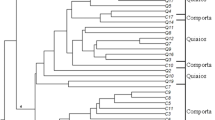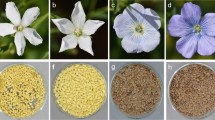Abstract
Genetic diversity provides valuable genetic resources and forms the basis of plant breeding. Plant leaves are closely connected to the external environment and play important roles in plant growth and development. Here, 13 cultivars of Camellia yuhsienensis were collected from Southern China to examine the magnitude of genetic diversity and differentiation, using cluster analysis based on 21 leaf traits and ten Inter simple sequence repeat (ISSR) markers. Morphological study indicated that all traits varied to different degrees, indicating a high degree of genetic diversity in C. yuhsienensis. Eight typical leaf characteristics were screened using principal component analysis, which showed that the selected traits were highly correlated and clustered. Average polymorphism percentage was obtained from the ISSR marker pattern using ten primers. A total of 201 loci were amplified, of which 175 were polymorphic with an average polymorphism percentage of 87.06%. Polymorphism information content (PIC), marker index (MI) and resolving power (RP) revealed that the selected primers were found to be informative in distinguishing C. yuhsienensis germplasm resources. Nei's diversity Index and the Shannon’s diversity index values indicated a certain level of genetic diversity. Cluster analysis results based on leaf structure and molecular markers were generally consistent, indicating a high degree of effective loci for morphological markers of C. yuhsienensis. Our results revealed genetic differences and commonalities among the cultivars, providing valuable information to identify appropriate seedling cultivars and conserve germplasm resources for future utilization.




Similar content being viewed by others
Data availability
No datasets were generated or analysed during the current study.
References
Budak H, Shearman RC, Parmaksiz I et al (2004) Comparative analysis of seeded and vegetative biotype buffalograsses based on phylogenetic relationship using ISSRs, SSRs, RAPDs, and SRAPs. Theor Appl Genet 109:280–288
Cai DS, Pei XX, Min XX et al (2023) Comparative analysis of anatomical structure and photosynthetic characteristics of Camellia oleifera leaves in “Sanhua Series.” Anhui Agric Sci Bull 29:52–57
Cao LQ, Zhong QP, Zou YL et al (2023) Leaf structure variations and relationship with environmental factors among germplasm resources of Vernicia fordii. J Nan**g for Univ (nat Sci Ed) 47:95–102
Chen Y, Yuan DY, Li YM et al (2020) Floral morphological and breeding characteristics of the F1 generation of Camellia. J Fujian Agric for Univ (nat Sci Ed) 49:440–446
Chen L (2020) Phenotype evaluation and analysis of genetic diversity based on SSR molecular markers of wild Camellia oleifera in **nxian. Dissertation. Jiangxi Agricultural University. (in Chinese)
Gong W, **ao S, Wang L et al (2022) Chromosome-level genome of Camellia lanceoleosa provides a valuable resource for understanding genome evolution and self-incompatibility. Plant J 110:881–898. https://doi.org/10.1111/tpj.15739
Guo Y, Zhang SH, Li Y et al (2022) Diversity analysis of 36 leaf phenotypic traits of Chinese chestnut. Sci Agric Sin 55:991–1009
He ZL, Liu CX, Wang XN et al (2020) Assessment of genetic diversity in Camellia oleifera Abel. accessions using morphological traits and simple sequence repeat (SSR) markers. Breed Sci 70:586–593. https://doi.org/10.1270/JSBBS.20066
Hu Y, Yang L, Gao C et al (2022) A comparative study on the leaf anatomical structure of Camellia oleifera in a low-hot valley area in Guizhou Province, China. PLoS ONE 17:e0262509. https://doi.org/10.1371/JOURNAL.PONE.0262509
Jiang Y, Yao XH, Cao YQ et al (2016) Variation and comprehensive evaluation of fruit quality of “Changlin” series of Camellia oleifera at different distribution regions. Nonwood Forest Research 34:42–48
Khan RT, Abbas SR, Ahmed SD (2020) Assessment of genetic diversity of tomato genotypes by using molecular markers. Pure Appl Biol 9:1532–1540. https://doi.org/10.19045/bspab.2020.90160
Li J, Li DD, Wang L et al (2023) Analysis of leaf anatomical structure of 43 tea plant (Camellia sinensis) germplasm resources in Hanzhong. Acta Agric Boreali-Occidentalis Sin 32:62–71
Li GS (2015) The research of ISSR on relationship 5 species of wild camellia of genus camellia and fingerprint construction. Dissertation. Central South University of Forestry & Technology Publishing. (in Chinese)
Lin P, Wang KL, Wang Y et al (2022) The genome of oil-Camellia and population genomics analysis provide insights into seed oil domestication. Genome Biol 23:14. https://doi.org/10.1186/s13059-021-02599-2
Lin P, Wang KL, Yao XH, Ren HD (2023) Development of DNA molecular ID in Camellia oleifera germplasm based on transcriptome-wide SNPs. Sci Agric Sin 56:217–235
Peng FZ, Wu YY, Hao MZ et al (2012) Genetic diversity of Camellia oleifera using ISSR and SRAP markers. J Nan**g for Univ (nat Sci Ed) 36:19–25
Qi HS, Sun XX, Yan WP et al (2022) Genetic relationships and low diversity among the tea-oil Camellia species in Sect. Oleifera, a bulk woody oil crop in China. Front Plant Sci 13:996731–996731. https://doi.org/10.3389/FPLS.2022.996731
Ray A, Jena S, Haldar T et al (2019) Population genetic structure and diversity analysis in Hedychium coronarium populations using morphological, phytochemical and molecular markers. Ind Crops Prod 132:118–133. https://doi.org/10.1016/j.indcrop.2019.02.015
Ren W (2019) Genetic diversity and cross compatibility of elite genotypes in Camellia oleifera. Dissertation. Fujian Agriculture and Forestry University. (in Chinese)
Seyit AK, Erdogan EH, Emine P (2010) Comparison of effectiveness of ISSR and RAPD markers in genetic characterization of seized marijuana (Cannabis sativa L.) in Turkey. Afr J Agr Res 5:2925–2933
Shen TF, Huang B, Xu M et al (2022) The reference genome of Camellia chekiangoleosa provides insights into Camellia evolution and tea oil biosynthesis. Hortic Res 9:3692–3702. https://doi.org/10.1093/hr/uhab083
Song QQ, Fu MW, He YF et al (2017) ISSR analysis of genetic diversity of Camellia chekiangoleosa Hu in Fujian province. J Sichuan Agric Univ 35:370–374
Tan, (2023) Advances in the molecular breeding of Camellia oleifera. J Cent South Univ for Technol 43:1–24
Xu Y, Huang L, Li JH et al (2022) Identification and genetic diversity analysis of olive cultivars in Longnan based on phenotype and SSR markers. For Res 35:33–43
Yan CY, Li JX, He YM et al (2014) Genetic diversity of 30 Camellia oleifera germplasms by using SRAP marker. Genomics Appl Biol 33:617–623
Yan C, Lin P, Lyu T et al (2018) Unraveling the roles of regulatory genes during domestication of cultivated Camellia: evidence and insights from comparative and evolutionary genomics. Genes 9:488. https://doi.org/10.3390/genes9100488
Yan HQ, Qi HS, Li Y et al (2022) Assessment of the genetic relationship and population structure in oil-tea Camellia species using simple sequence repeat (SSR) markers. Genes 13:2162–2162. https://doi.org/10.3390/GENES13112162
Yan M (2020) Genetic diversity analysis and regional applicability evaluation of Camellia oleifera varieties in Jiangxi province. Dissertation. Jiangxi Agricultural University. (in Chinese)
Yang Y, Yuan DY, Liu DM et al (2020) Effect of different pollination method on fruit setting rate and fruit growth of Camellia yubsienensis Hu. J Cent S Univ for Technol 36:61–65
Yao XH, Huang Y, Ren HD et al (2014) Analysis on the leaf phenotype frequency distribution and diversity index of Camellia meiocarpa different populations. J Southwest for Univ 34:47–52
Yu XY, Yu FY, Liu JB et al (2013) Identification and genetic diversity analysis of Camellia oleifera varieties using ISSR marker. J Nan**g for Univ (nat Sci Ed) 37:61–66
Zhang P, Yang Y, ** RC et al (2018) Leaf phenotypic variation in populations of Camellia gauchowensis. For Environ Sci 34:13–19
Zhang TJ (2019) Phenotypic and anatomical diversity of leaf of Davidia involucrata natural populations in Sichuan province. Dissertation. Sichuan Agricultural University. (in Chinese)
Zhou CC, Yang DM, Li SK et al (2020) Genetic relationship analysis of 18 Cerasus material based on inter-simple sequence repeat molecular marker. J for Environ 40:46–53
Zhou LY (2014) ISSR analysis on the diversity of oil-tea camellia germplasms. Dissertation. Hunan Normal University. (in Chinese)
Zhu YL, Guo FG (2020) Genetic diversity analysis of Cotoneaster buxifolius in Yunnan Province based on phenotype characters and ISSR marker. For Res 33:19–26
Zhu YZ, Liang DY, Song ZJ et al (2022) Genetic diversity analysis and core germplasm collection construction of Camellia oleifera based on fruit phenotype and SSR data. Genes 13:2351–2351. https://doi.org/10.3390/GENES13122351
Acknowledgements
We would like to thank Editage (www.editage.cn) for English language editing.
Funding
This research was supported by Fundamental Research Funds for the Central Non-profit Research Institution (CAFYBB2021MA003, CAFYBB2023ZA001-2, CAFYBB2019MB003).
Author information
Authors and Affiliations
Contributions
QZ and LC conceived and designed the study. DC, ZC, YY, HG and JW collected the samples. YZ, XG, CY and YZ collected and analyzed the data. YZ wrote the manuscript. LC revised the manuscript accordingly. All the authors have read and approved the final manuscript.
Corresponding authors
Ethics declarations
Conflict of interest
The authors declare no conflicts of interest regarding the publication of this paper.
Additional information
Publisher's Note
Springer Nature remains neutral with regard to jurisdictional claims in published maps and institutional affiliations.
Rights and permissions
Springer Nature or its licensor (e.g. a society or other partner) holds exclusive rights to this article under a publishing agreement with the author(s) or other rightsholder(s); author self-archiving of the accepted manuscript version of this article is solely governed by the terms of such publishing agreement and applicable law.
About this article
Cite this article
Zou, Y., Ge, X., Yan, C. et al. Assessment of genetic diversity of Camellia yuhsienensis based on leaf structure and inter simple sequence repeat (ISSR) markers. Genet Resour Crop Evol (2024). https://doi.org/10.1007/s10722-024-01910-x
Received:
Accepted:
Published:
DOI: https://doi.org/10.1007/s10722-024-01910-x




